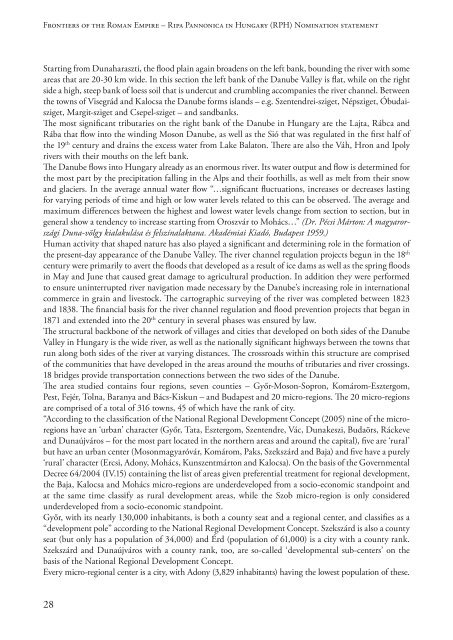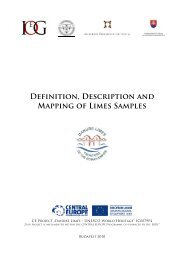the PDF version! - Danube Limes
the PDF version! - Danube Limes
the PDF version! - Danube Limes
You also want an ePaper? Increase the reach of your titles
YUMPU automatically turns print PDFs into web optimized ePapers that Google loves.
Frontiers of <strong>the</strong> Roman Empire – Ripa Pannonica in Hungary (RPH) Nomination statement<br />
Starting from Dunaharaszti, <strong>the</strong> flood plain again broadens on <strong>the</strong> left bank, bounding <strong>the</strong> river with some<br />
areas that are 20-30 km wide. In this section <strong>the</strong> left bank of <strong>the</strong> <strong>Danube</strong> Valley is flat, while on <strong>the</strong> right<br />
side a high, steep bank of loess soil that is undercut and crumbling accompanies <strong>the</strong> river channel. Between<br />
<strong>the</strong> towns of Visegrád and Kalocsa <strong>the</strong> <strong>Danube</strong> forms islands – e.g. Szentendrei-sziget, Népsziget, Óbudaisziget,<br />
Margit-sziget and Csepel-sziget – and sandbanks.<br />
The most significant tributaries on <strong>the</strong> right bank of <strong>the</strong> <strong>Danube</strong> in Hungary are <strong>the</strong> Lajta, Rábca and<br />
Rába that flow into <strong>the</strong> winding Moson <strong>Danube</strong>, as well as <strong>the</strong> Sió that was regulated in <strong>the</strong> first half of<br />
<strong>the</strong> 19 th century and drains <strong>the</strong> excess water from Lake Balaton. There are also <strong>the</strong> Váh, Hron and Ipoly<br />
rivers with <strong>the</strong>ir mouths on <strong>the</strong> left bank.<br />
The <strong>Danube</strong> flows into Hungary already as an enormous river. Its water output and flow is determined for<br />
<strong>the</strong> most part by <strong>the</strong> precipitation falling in <strong>the</strong> Alps and <strong>the</strong>ir foothills, as well as melt from <strong>the</strong>ir snow<br />
and glaciers. In <strong>the</strong> average annual water flow “…significant fluctuations, increases or decreases lasting<br />
for varying periods of time and high or low water levels related to this can be observed. The average and<br />
maximum differences between <strong>the</strong> highest and lowest water levels change from section to section, but in<br />
general show a tendency to increase starting from Oroszvár to Mohács…” (Dr. Pécsi Márton: A magyarországi<br />
Duna-völgy kialakulása és felszínalaktana. Akadémiai Kiadó, Budapest 1959.)<br />
Human activity that shaped nature has also played a significant and determining role in <strong>the</strong> formation of<br />
<strong>the</strong> present-day appearance of <strong>the</strong> <strong>Danube</strong> Valley. The river channel regulation projects begun in <strong>the</strong> 18 th<br />
century were primarily to avert <strong>the</strong> floods that developed as a result of ice dams as well as <strong>the</strong> spring floods<br />
in May and June that caused great damage to agricultural production. In addition <strong>the</strong>y were performed<br />
to ensure uninterrupted river navigation made necessary by <strong>the</strong> <strong>Danube</strong>’s increasing role in international<br />
commerce in grain and livestock. The cartographic surveying of <strong>the</strong> river was completed between 1823<br />
and 1838. The financial basis for <strong>the</strong> river channel regulation and flood prevention projects that began in<br />
1871 and extended into <strong>the</strong> 20 th century in several phases was ensured by law.<br />
The structural backbone of <strong>the</strong> network of villages and cities that developed on both sides of <strong>the</strong> <strong>Danube</strong><br />
Valley in Hungary is <strong>the</strong> wide river, as well as <strong>the</strong> nationally significant highways between <strong>the</strong> towns that<br />
run along both sides of <strong>the</strong> river at varying distances. The crossroads within this structure are comprised<br />
of <strong>the</strong> communities that have developed in <strong>the</strong> areas around <strong>the</strong> mouths of tributaries and river crossings.<br />
18 bridges provide transportation connections between <strong>the</strong> two sides of <strong>the</strong> <strong>Danube</strong>.<br />
The area studied contains four regions, seven counties – Győr-Moson-Sopron, Komárom-Esztergom,<br />
Pest, Fejér, Tolna, Baranya and Bács-Kiskun – and Budapest and 20 micro-regions. The 20 micro-regions<br />
are comprised of a total of 316 towns, 45 of which have <strong>the</strong> rank of city.<br />
“According to <strong>the</strong> classification of <strong>the</strong> National Regional Development Concept (2005) nine of <strong>the</strong> microregions<br />
have an ‘urban’ character (Győr, Tata, Esztergom, Szentendre, Vác, Dunakeszi, Budaörs, Ráckeve<br />
and Dunaújváros – for <strong>the</strong> most part located in <strong>the</strong> nor<strong>the</strong>rn areas and around <strong>the</strong> capital), five are ‘rural’<br />
but have an urban center (Mosonmagyaróvár, Komárom, Paks, Szekszárd and Baja) and five have a purely<br />
‘rural’ character (Ercsi, Adony, Mohács, Kunszentmárton and Kalocsa). On <strong>the</strong> basis of <strong>the</strong> Governmental<br />
Decree 64/2004 (IV.15) containing <strong>the</strong> list of areas given preferential treatment for regional development,<br />
<strong>the</strong> Baja, Kalocsa and Mohács micro-regions are underdeveloped from a socio-economic standpoint and<br />
at <strong>the</strong> same time classify as rural development areas, while <strong>the</strong> Szob micro-region is only considered<br />
underdeveloped from a socio-economic standpoint.<br />
Győr, with its nearly 130,000 inhabitants, is both a county seat and a regional center, and classifies as a<br />
“development pole” according to <strong>the</strong> National Regional Development Concept. Szekszárd is also a county<br />
seat (but only has a population of 34,000) and Érd (population of 61,000) is a city with a county rank.<br />
Szekszárd and Dunaújváros with a county rank, too, are so-called ‘developmental sub-centers’ on <strong>the</strong><br />
basis of <strong>the</strong> National Regional Development Concept.<br />
Every micro-regional center is a city, with Adony (3,829 inhabitants) having <strong>the</strong> lowest population of <strong>the</strong>se.<br />
28











